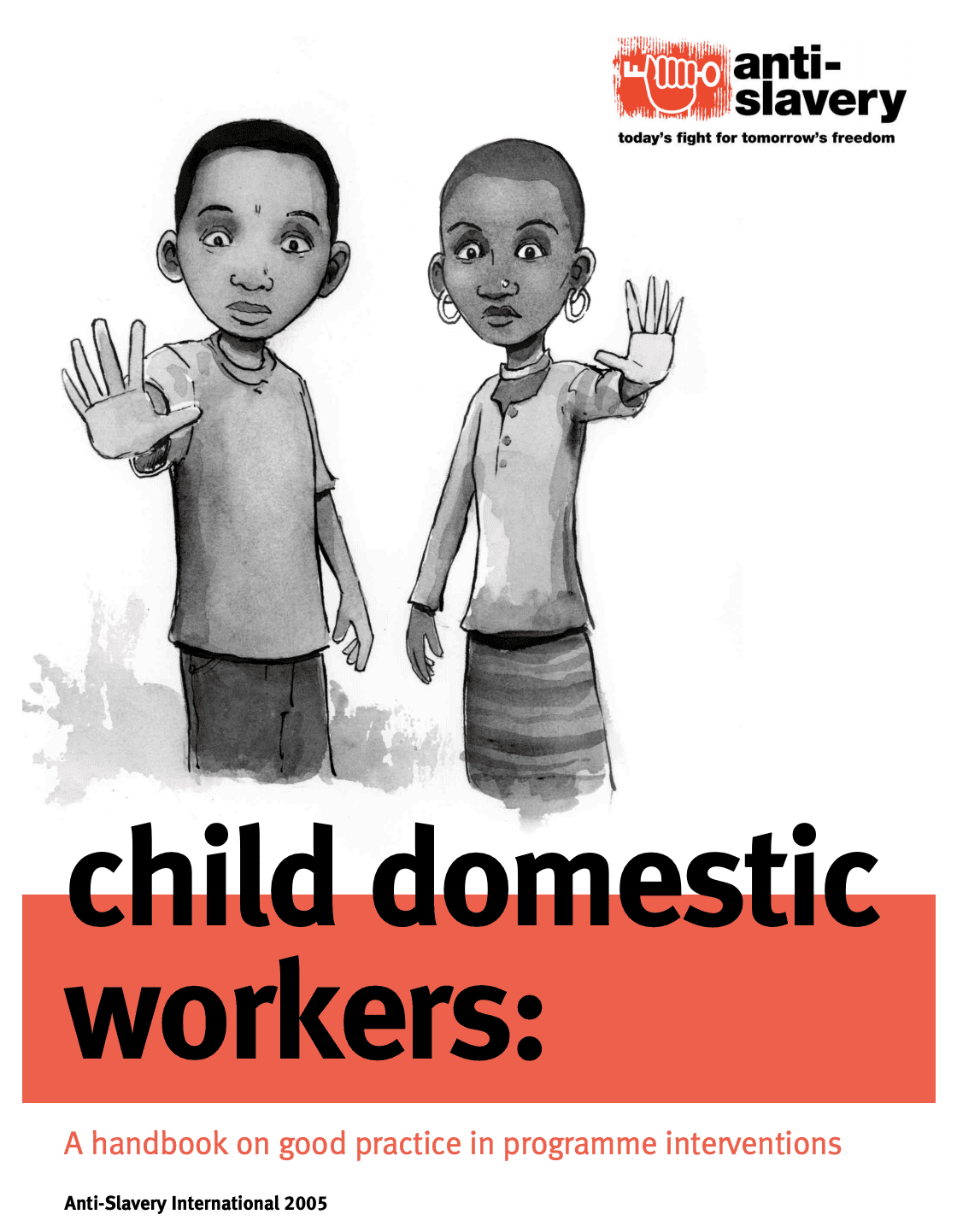
Child Domestic Workers: A handbook on good practice in programme interventions
Child domestic workers were for long an invisible group of working children. Today, they are recognised as among the most numerous of all child workers, and certainly the overwhelming category as far as girls are concerned. Previous assumptions – notably that girls brought up in the households of better-off patrons in return for light housework were neither really ‘workers’ nor ‘at risk’ – are gradually being dispelled by the greater volume of evidence surrounding their employment. Their own voices, mute for so long because of their isolated and discriminated situation, are now also being heard.
Anti-Slavery International has been in the forefront of work to raise the visibility of child domestic workers, working with partners in Asia, Africa and Latin America to promote their cause and reduce their sufferings. There are many reasons to take up this issue, but in the view of Anti-Slavery International, the servitude of these young employees, their frequent loss of liberty, methods of recruitment which can amount to trafficking, and low rates of pay including its total absence, put them in a category of human rights violation closer to slavery than many other child worker groups. Anti-Slavery International held its first international meeting of non-governmental organisation (NGO) practitioners concerned with child domestic workers in 1996, and subsequently published: Child Domestic Workers: A handbook for research and action. A second international meeting was held in 2001 with a larger group of practitioners, out of which came a handbook on advocacy: Child Domestic Workers: Finding a voice.
In between these two meetings, the International Labour Organization (ILO) adopted the Worst Forms of Child Labour Convention No. 182 in 1999. From this point onwards, child domestic employment can be seen as having clearly entered international consciousness and begun to attract serious attention in the child labour community. Many of the characteristics which define ‘worst forms’ of child labour are now seen as applying to child domestic workers. The involvement of the ILO’s International Programme on the Elimination of Child Labour (IPEC) in their plight, including by support for a number of in-country programmes, has harnessed wider attention and resources, as well as brought new expertise and professionalism into the struggle.
In 2004, Anti-Slavery International embarked on a three-year project to give new support to the cause, with a network of key project partners in Asia, Africa, and Latin America and the Caribbean* and international assistance from Comic Relief and the Oak Foundation. The overall objective of the project is to identify what practical interventions on behalf of child domestic workers are most useful to them, and which offer them the best chance of protection from abuse and exploitation. By understanding ‘what works’ and why, it is hoped to improve the quality and scope of services currently provided to them and to those responsible for them (such as parents and employers), and to encourage other NGOs to intervene on their behalf. In current development parlance, ‘what works’ is often known by the term ‘good practice’, and this is a term the project has adopted.
In November 2004, Anti-Slavery International convened an international practitioners meeting in Bangkok, Thailand, to exchange views and experiences on ‘good practice’ among concerned NGOs and others. In the course of baseline surveys conducted earlier in the year, 67 projects were identified in 28 countries; some of the representatives of these projects joined the network and participated in the discussions for the first time. Consultations with almost 500 current and former child domestic workers (CDWs) in nine countries were also conducted during 2004, and the results of these were fed into to the meeting’s deliberations. Altogether, more than 40 participants took part, of whom 30 were representatives of NGOs and six of international organisations and networks.
This handbook therefore draws heavily on the presentations, discussions and materials brought to that forum, and its content has been developed with the participation of those present. The range of programme and organisational examples is therefore necessarily circumscribed: the handbook does not pretend to cover all existing CDW-related activity. Some areas, as is indicated in the text, have not been dealt with in detail where the previous handbook on advocacy already dealt with a subject in depth. This handbook is meant to complement the two earlier volumes, and has been produced in a similar style and format. The emphasis is on simplicity and practicality, and the key users of the handbook are expected to be small and medium-sized NGOs seeking ways to improve programmes and projects, or add to their existing portfolio of activities on CDWs’ behalf.
The approach taken is specific to this particular group of child workers; but it is not prescriptive. Each section articulates ‘good practice principles’ rather than defines good practices themselves; it should be understood that the term ‘good practice’ is not used here in a normative sense. Good practices in one setting may not be good practices in another, given the diversity of situations and appropriate responses in different parts of the world and among different groups within the same country. Anti-Slavery International’s hope is that the handbook will provide a range of examples and lessons learned during the course of undertaking different types of activity from which all kinds of practitioners can draw value.
Anti-Slavery International and its partners in the field also hope that the publication of the handbook will inspire new partners to come forward, especially from workers’ and employers’ organisations and relevant government departments and regulatory bodies. Only when those who currently employ children as workers in their homes are sensitized to the many ways in which their childhood and adolescence are being damaged will the necessary changes in attitude and behaviour towards this oppressed group of workers start to take hold.
Read more here.
